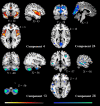Ameliorative patterns of grey matter in patients with first-episode and treatment-naïve schizophrenia
- PMID: 35164887
- PMCID: PMC10277763
- DOI: 10.1017/S0033291722000058
Ameliorative patterns of grey matter in patients with first-episode and treatment-naïve schizophrenia
Abstract
Background: Grey matter (GM) reduction is a consistent observation in established late stages of schizophrenia, but patients in the untreated early stages of illness display an increase as well as a decrease in GM distribution relative to healthy controls (HC). The relative excess of GM may indicate putative compensatory responses, though to date its relevance is unclear.
Methods: 343 first-episode treatment-naïve patients with schizophrenia (FES) and 342 HC were recruited. Multivariate source-based morphometry was performed to identify covarying 'networks' of grey matter concentration (GMC). Neurocognitive scores using the Cambridge Neuropsychological Test Automated Battery (CANTAB) and symptom burden using the Positive and Negative Symptoms Scale (PANSS) were obtained. Bivariate linear relationships between GMC and cognition/symptoms were studied.
Results: Compared to healthy subjects, FES had prominently lower GMC in two components; the first consists of the anterior insula, inferior frontal gyrus, anterior cingulate and the second component with the superior temporal gyrus, precuneus, inferior/superior parietal lobule, cuneus, and lingual gyrus. Higher GMC was seen in adjacent areas of the middle and superior temporal gyrus, middle frontal gyrus, inferior parietal cortex and putamen. Greater GMC of this component was associated with lower duration of untreated psychosis, less severe positive symptoms and better performance on cognitive tests.
Conclusions: In untreated stages of schizophrenia, both a distributed lower and higher GMC is observable. While the higher GMC is relatively modest, it occurs across frontoparietal, temporal and subcortical regions in association with reduced illness burden suggesting a compensatory role for higher GMC in the early stages of schizophrenia.
Keywords: compensatory; early intervention; morphometry; neurocognition; psychosis.
Conflict of interest statement
LP reports personal fees from Janssen Canada, Otsuka Canada, SPMM Course Limited, UK, Canadian Psychiatric Association; book royalties from Oxford University Press; investigator-initiated educational grants from Janssen Canada, Sunovion and Otsuka Canada outside the submitted work. All other authors report no relevant conflicts.
Figures


Similar articles
-
Association of cerebral deficits with clinical symptoms in antipsychotic-naive first-episode schizophrenia: an optimized voxel-based morphometry and resting state functional connectivity study.Am J Psychiatry. 2009 Feb;166(2):196-205. doi: 10.1176/appi.ajp.2008.08020183. Epub 2008 Nov 3. Am J Psychiatry. 2009. PMID: 18981063
-
Structural and functional brain abnormalities in schizophrenia: A cross-sectional study at different stages of the disease.Prog Neuropsychopharmacol Biol Psychiatry. 2018 Apr 20;83:27-32. doi: 10.1016/j.pnpbp.2017.12.017. Epub 2017 Dec 29. Prog Neuropsychopharmacol Biol Psychiatry. 2018. PMID: 29292241
-
Gray matter volume changes following antipsychotic therapy in first-episode schizophrenia patients: A longitudinal voxel-based morphometric study.J Psychiatr Res. 2019 Sep;116:126-132. doi: 10.1016/j.jpsychires.2019.06.009. Epub 2019 Jun 15. J Psychiatr Res. 2019. PMID: 31233895
-
Structural brain changes in schizophrenia at different stages of the illness: A selective review of longitudinal magnetic resonance imaging studies.Aust N Z J Psychiatry. 2017 May;51(5):500-508. doi: 10.1177/0004867417699473. Epub 2017 Mar 21. Aust N Z J Psychiatry. 2017. PMID: 28415873 Review.
-
Grey matter volume abnormalities in the first depressive episode of medication-naïve adult individuals: a systematic review of voxel based morphometric studies.Int J Psychiatry Clin Pract. 2021 Nov;25(4):407-420. doi: 10.1080/13651501.2020.1861632. Epub 2020 Dec 22. Int J Psychiatry Clin Pract. 2021. PMID: 33351672
Cited by
-
Childhood trauma and inflammatory biomarker effects on cortical thinning in schizophrenia spectrum disorders.Brain Behav Immun Health. 2025 Jul 4;48:101055. doi: 10.1016/j.bbih.2025.101055. eCollection 2025 Oct. Brain Behav Immun Health. 2025. PMID: 40686935 Free PMC article.
-
Structural Cerebellar and Lateral Frontoparietal Networks are altered in CUD: An SBM Analysis.Addict Biol. 2025 Mar;30(3):e70021. doi: 10.1111/adb.70021. Addict Biol. 2025. PMID: 40072344 Free PMC article.
-
Distinct structural deficits in treatment-resistant schizophrenia and their putative neurotransmitter basis: a source-based morphometry analysis.Neuropsychopharmacology. 2025 May 28. doi: 10.1038/s41386-025-02135-x. Online ahead of print. Neuropsychopharmacology. 2025. PMID: 40437012
-
Neurostructural changes in schizophrenia and treatment-resistance: a narrative review.Psychoradiology. 2024 Sep 6;4:kkae015. doi: 10.1093/psyrad/kkae015. eCollection 2024. Psychoradiology. 2024. PMID: 39399446 Free PMC article. Review.
-
Contrasting Frontoparietal Network Connectivity in Antipsychotic Medication-Naive First-Episode Psychosis Patients Who Do and Do Not Display Features of the Deficit Syndrome.Schizophr Bull. 2022 Nov 18;48(6):1344-1353. doi: 10.1093/schbul/sbac081. Schizophr Bull. 2022. PMID: 35869578 Free PMC article.
References
MeSH terms
Grants and funding
LinkOut - more resources
Full Text Sources
Medical
Miscellaneous

